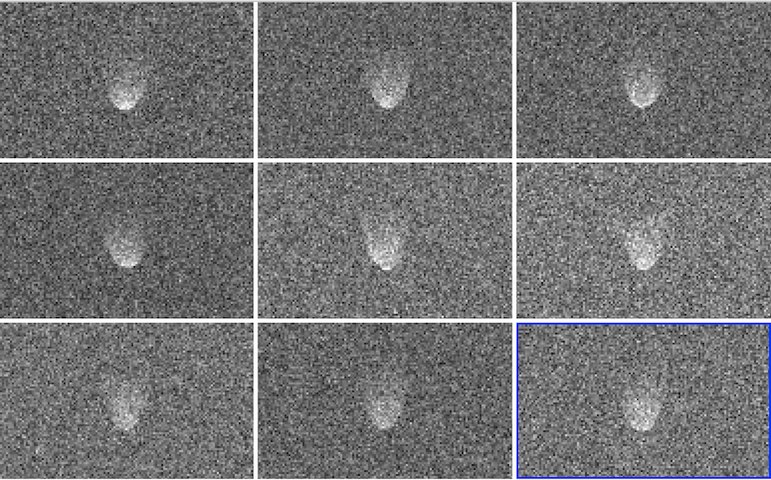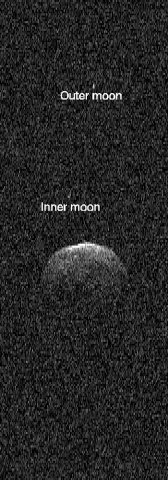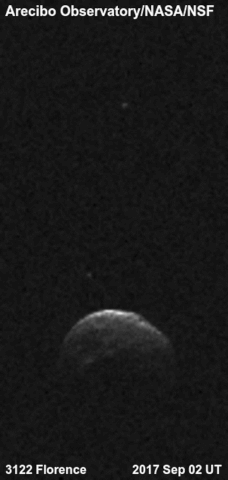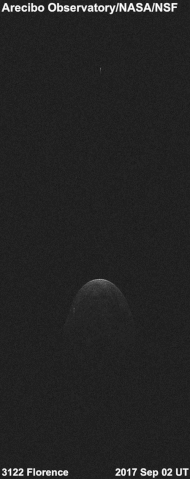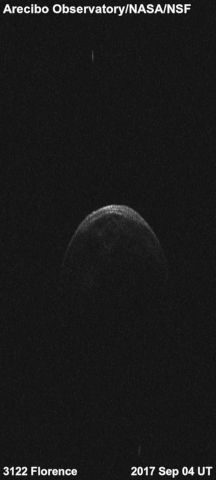 Arecibo radar imaging of 3122 Florence orbited by two minor-planet moons on 4 September 2017 Arecibo radar imaging of 3122 Florence orbited by two minor-planet moons on 4 September 2017 | |
| Discovery | |
|---|---|
| Discovered by | Schelte J. "Bobby" Bus |
| Discovery site | Siding Spring Obs. |
| Discovery date | 2 March 1981 (43 years ago) (1981-03-02) |
| Designations | |
| MPC designation | (3122) Florence |
| Pronunciation | /ˈflɒrəns/ |
| Named after | Florence Nightingale (English nurse) |
| Alternative designations | 1981 ET3 · 1983 CN1 |
| Minor planet category | Amor · NEO · PHA |
| Orbital characteristics | |
| Epoch 4 September 2017 (JD 2458000.5) | |
| Uncertainty parameter 0 | |
| Observation arc | 38.52 yr (14,069 days) |
| Aphelion | 2.5180 AU |
| Perihelion | 1.0203 AU |
| Semi-major axis | 1.7691 AU |
| Eccentricity | 0.4233 |
| Orbital period (sidereal) | 2.35 yr (859 days) |
| Mean anomaly | 351.44° |
| Mean motion | 0° 25 8.04 / day |
| Inclination | 22.151° |
| Longitude of ascending node | 336.10° |
| Argument of perihelion | 27.847° |
| Known satellites | 2 |
| Earth MOID | 0.0443 AU · 17.3 LD |
| Physical characteristics | |
| Mean diameter | 4.010±1.237 km 4.349 km 4.35 km (taken) 4.401±0.030 km 4.9 km |
| Mean density | 1.4 g/cm |
| Synodic rotation period | 2.3580±0.0002 h 2.3581 h 2.3582±0.0003 h 2.3588±0.0008 h 2.359±0.001 h 2.359±0.003 h 5±1 h |
| Geometric albedo | 0.146 0.21±0.20 0.231±0.049 0.258±0.199 |
| Spectral type | SMASS = S · Sq |
| Absolute magnitude (H) | 13.87±0.1 (R) · 14.0 · 14.04±0.1 (R) · 14.1 · 14.515±0.11 · 14.65±0.11 · 14.65±0.3 |
3122 Florence is a stony trinary asteroid of the Amor group. It is classified as a near-Earth object and potentially hazardous asteroid. It measures approximately 5 kilometers in diameter. It orbits the Sun at a distance of 1.0–2.5 AU once every 2 years and 4 months (859 days); the orbit has an eccentricity of 0.42 and an inclination of 22° with respect to the ecliptic. Florence has two moons.
Florence was discovered on 2 March 1981 by American astronomer Schelte J. "Bobby" Bus at Siding Spring Observatory. Its provisional designation was 1981 ET3. It was named in honor of Florence Nightingale, the founder of modern nursing; the naming citation was published on 6 April 1993 (M.P.C. 21955).
Florence is classified as a potentially hazardous object because its minimum orbit intersection distance (MOID ≤ 0.05 AU) indicates that it has the potential to make close approaches to the Earth, and because measurements of its absolute magnitude (H ≤ 22) suggest that it is large enough to create serious damage were it to impact.
Moons
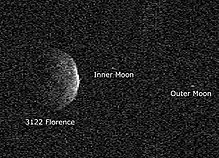
Radar observations during the 2017 flyby have shown that Florence has two moons. The inner of the two moons is estimated to have a diameter of 180 to 240 meters, the outer moon is between 300 and 360 meters across. Each moon is somewhat elongated, and both are tidally locked to the main body. They probably formed as loose material spun away from the main body as its rotation accelerated due to the YORP effect.
The inner moon's period orbiting Florence appears to be approximately 7 hours, while the outer moon completes a revolution in about 21 to 23 hours. The inner moon of Florence has the shortest orbital period of any of the moons of the 60 near-Earth asteroids known to have moons.
Florence is only the third known trinary asteroid in the near-Earth asteroid population, after (153591) 2001 SN263 and (136617) 1994 CC.
2017 close approach
On 1 September 2017, Florence passed 0.047237 AU (7,066,600 km; 4,391,000 mi) from Earth, approximately eighteen times the average distance of the Moon. As seen from Earth, it brightened to apparent magnitude 8.5, and was visible in small telescopes for several nights as it moved south to north through the constellations Piscis Austrinus, Capricornus, Aquarius, and Delphinus. This was the asteroid's closest approach since 1890 and the closest until after 2500. Its previous flyby was on 29 August 1930, at a distance of 0.05239 AU and the next one will be on 2 September 2057, at 0.049952 AU.
-
 Animation: 2017-08-30 21:48:46 to 22:53:00 UTC
Animation: 2017-08-30 21:48:46 to 22:53:00 UTC
-
 3122 Florence passing the Earth in 2017
3122 Florence passing the Earth in 2017
-
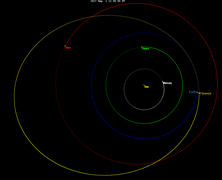 Orbit of Florence
Orbit of Florence
-
 Daily motion of 3122 Florence as seen from earth near 1 September 2017 flyby.
Daily motion of 3122 Florence as seen from earth near 1 September 2017 flyby.
Radar imagery
During the flyby, scientists studied Florence using the Arecibo Observatory and the Goldstone Deep Space Communications Complex, and discovered that it has two moons.
- Goldstone Radar
- Arecibo Radar
Notes
- ^ Pravec (2002/2003) web: rotation period 2.3581±0.0001 hours with a brightness amplitude of 0.15 and 0.18 mag, respectively. Summary figures at Collaborative Asteroid Lightcurve Link (CALL) for (3122) Florence and Pravec, P.; Wolf, M.; Sarounova, L. (2002)
References
- ^ "JPL Small-Body Database Browser: 3122 Florence (1981 ET3)" (2016-05-28 last obs.). Jet Propulsion Laboratory. Retrieved 7 January 2017.
- "Florence". Lexico UK English Dictionary. Oxford University Press. Archived from the original on 23 March 2020.
- ^ Schmadel, Lutz D. (2007). "(3122) Florence". Dictionary of Minor Planet Names – (3122) Florence. Springer Berlin Heidelberg. p. 258. doi:10.1007/978-3-540-29925-7_3123. ISBN 978-3-540-00238-3.
- ^ "3122 Florence (1981 ET3)". Minor Planet Center. Retrieved 7 January 2017.
- ^ Mainzer, A.; Grav, T.; Masiero, J.; Bauer, J.; Cutri, R. M.; McMillan, R. S.; et al. (November 2012). "Physical Parameters of Asteroids Estimated from the WISE 3-Band Data and NEOWISE Post-Cryogenic Survey". The Astrophysical Journal Letters. 760 (1): 6. arXiv:1210.0502. Bibcode:2012ApJ...760L..12M. doi:10.1088/2041-8205/760/1/L12. S2CID 41459166. Retrieved 7 January 2017.
- ^ Pravec, Petr; Harris, Alan W.; Kusnirák, Peter; Galád, Adrián; Hornoch, Kamil (September 2012). "Absolute magnitudes of asteroids and a revision of asteroid albedo estimates from WISE thermal observations". Icarus. 221 (1): 365–387. Bibcode:2012Icar..221..365P. doi:10.1016/j.icarus.2012.07.026. Retrieved 7 January 2017.
- ^ "LCDB Data for (3122) Florence". Asteroid Lightcurve Database (LCDB). Retrieved 7 January 2017.
- "(3122) Florence". The Near-Earth Asteroids Data Base at E.A.R.N. Archived from the original on 12 August 2012. Retrieved 30 August 2017.
- ^ Mainzer, A.; Grav, T.; Masiero, J.; Hand, E.; Bauer, J.; Tholen, D.; et al. (November 2011). "NEOWISE Studies of Spectrophotometrically Classified Asteroids: Preliminary Results". The Astrophysical Journal. 741 (2): 25. arXiv:1109.6407. Bibcode:2011ApJ...741...90M. doi:10.1088/0004-637X/741/2/90. S2CID 35447010.
- ^ "Telescopes Worldwide Collaborate to Observe Asteroid Florence During its Recent Close Approach to Earth". Jet Propulsion Laboratory. 11 September 2017. Retrieved 14 September 2017.
- Warner, Brian D. (July 2016). "Near-Earth Asteroid Lightcurve Analysis at CS3-Palmer Divide Station: 2016 January–April". The Minor Planet Bulletin. 43 (3): 240–250. Bibcode:2016MPBu...43..240W. ISSN 1052-8091. PMC 7288611. PMID 32539024.
- Pravec, Petr; Wolf, Marek; Sarounová, Lenka (November 1998). "Lightcurves of 26 Near-Earth Asteroids". Icarus. 136 (1): 124–153. Bibcode:1998Icar..136..124P. doi:10.1006/icar.1998.5993. Retrieved 7 January 2017.
- Behrend, Raoul. "Asteroids and comets rotation curves – (3122) Florence". Geneva Observatory. Retrieved 7 January 2017.
- Linder, Tyler R.; Sampson, Ryan; Holmes, Robert (January 2013). "Astronomical Research Institute Photometric Results". The Minor Planet Bulletin. 40 (1): 4–6. Bibcode:2013MPBu...40....4L. ISSN 1052-8091. Retrieved 7 January 2017.
- Elenin, Leonid; Molotov, Igor (July 2012). "Asteroids Lightcurve Analysis at the Ison-NM Observatory: 3122 Florence, (25916) 2001 CP44, (47035) 1998 WS, (137170) 1999 HF1". The Minor Planet Bulletin. 39 (3): 101–102. Bibcode:2012MPBu...39..101E. ISSN 1052-8091. Retrieved 7 January 2017.
- ^ Wisniewski, W. Z.; Michalowski, T. M.; Harris, A. W.; McMillan, R. S. (March 1995). "Photoelectric Observations of 125 Asteroids". Abstracts of the Lunar and Planetary Science Conference. 26: 1511. Bibcode:1995LPI....26.1511W. Retrieved 7 January 2017.
- Thomas, C. A.; Trilling, D. E.; Emery, J. P.; Mueller, M.; Hora, J. L.; Benner, L. A. M.; et al. (September 2011). "ExploreNEOs. V. Average Albedo by Taxonomic Complex in the Near-Earth Asteroid Population". The Astronomical Journal. 142 (3): 12. Bibcode:2011AJ....142...85T. doi:10.1088/0004-6256/142/3/85.
- Mainzer, A.; Grav, T.; Bauer, J.; Masiero, J.; McMillan, R. S.; Cutri, R. M.; et al. (December 2011). "NEOWISE Observations of Near-Earth Objects: Preliminary Results". The Astrophysical Journal. 743 (2): 17. arXiv:1109.6400. Bibcode:2011ApJ...743..156M. doi:10.1088/0004-637X/743/2/156. hdl:11368/2963127. S2CID 239991. Retrieved 7 January 2017.
- Thomas, Cristina A.; Emery, Joshua P.; Trilling, David E.; Delbó, Marco; Hora, Joseph L.; Mueller, Michael (January 2014). "Physical characterization of Warm Spitzer-observed near-Earth objects". Icarus. 228: 217–246. arXiv:1310.2000. Bibcode:2014Icar..228..217T. doi:10.1016/j.icarus.2013.10.004. hdl:2060/20140012047. S2CID 119278697. Retrieved 7 January 2017.
- ^ "Radar Reveals Two Moons Orbiting Asteroid Florence". Jet Propulsion Laboratory. 1 September 2017. Retrieved 14 September 2017.
- "MPC/MPO/MPS Archive". Minor Planet Center. Retrieved 7 January 2017.
- "NEO Groups". Near Earth Object Program. NASA. Archived from the original on 2 November 2016.
- "JPL Close-Approach Data: 3122 Florence (1981 ET3)" (2017-08-30 last obs). Retrieved 30 August 2017.
- "Asteroid Besar dan Langka Lintasi Langit Indonesia Malam Ini". detik.com. 1 September 2017. Retrieved 5 September 2021.
- PTI (18 August 2017). "Nasa says big asteroid to pass safely by Earth on 1 September". Livemint.
- "Asteroid Florence Pays Earth a Visit – Sky & Telescope". 30 August 2017. Retrieved 1 September 2017.
- "See Florence, One Of The Largest Near-Earth Asteroids, Zip By Earth". 30 August 2017. Retrieved 1 September 2017.
- ^ "Goldstone Radar Observations Planning: Asteroid 3122 Florence and 2001 QL142". NASA. 29 August 2017.
- ^ "Arecibo announces two moons (September 2nd)". Twitter. 2 September 2017.
- "Arecibo imagery from September 2nd (5x higher resolution)". Twitter. 2 September 2017.
- "Arecibo reveals surface features of 3122 Florence". Twitter. 3 September 2017.
- "One full rotation of 3122 Florence, as seen from Arecibo". Twitter. 4 September 2017.
- "Last images of 3122 Florence from Arecibo". Twitter. 5 September 2017.
External links
- NASA Goldstone Radar Discovers 2 Moons Orbiting Florence on YouTube
- (3122) Florence, Asteroids with Satellites Database—Johnston's Archive
- Asteroid Florence found to have 2 moons, Eddie Irizarry, 2 September 2017
- Lightcurve plot, Brian D. Warner, Center for Solar System Studies, Spring 2016
- Asteroid Lightcurve Database (LCDB), query form (info Archived 16 December 2017 at the Wayback Machine)
- Dictionary of Minor Planet Names, Google books
- Asteroids and comets rotation curves, CdR – Observatoire de Genève, Raoul Behrend
- 3122 Florence at NeoDyS-2, Near Earth Objects—Dynamic Site
- 3122 Florence at ESA–space situational awareness
- 3122 Florence at the JPL Small-Body Database

| Minor planets navigator | |
|---|---|
| Small Solar System bodies | |||||||
|---|---|---|---|---|---|---|---|
| Minor planets |
| ||||||
| Comets | |||||||
| Other | |||||||
| 2017 in space | ||
|---|---|---|
| Space probe launches |
|    |
| Impact events | ||
| Selected NEOs | ||
| Exoplanets | ||
| Discoveries | ||
| Comets | ||
| Space exploration |
| |
